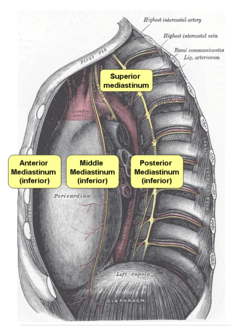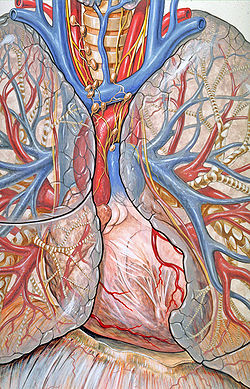- Mediastinum
-
Mediastinum 
Mediastinum. The division between superior and inferior is at the sternal angle. 
Mediastinum anatomy Gray's subject #239 1090 The mediastinum is a non-delineated group of structures in the thorax, surrounded by loose connective tissue. It is the central compartment of the thoracic cavity. It contains the heart, the great vessels of the heart, esophagus, trachea, phrenic nerve, cardiac nerve, thoracic duct, thymus, and lymph nodes of the central chest.
Contents
Anatomy
The mediastinum lies between the right and left pleura in and near the median sagittal plane of the chest. It extends from the sternum in front to the vertebral column behind, and contains all the thoracic viscera except the lungs. It may be divided for purposes of description into two parts:
- an upper portion, above the upper level of the pericardium, which is named the superior mediastinum with its superior limit at the superior thoracic aperture and its inferior limit at the plane from the sternal angle to the disc of T4-T5 (Plane of Ludwig at Angle of Louis);
- and a lower portion, below the upper level of the pericardium. This lower portion is again subdivided into three parts, viz.:
- that in front of the pericardium, the anterior mediastinum;
- that containing the pericardium and its contents, the middle mediastinum;
- and that behind the pericardium, the posterior mediastinum.
It is surrounded by the chest wall anteriorly, the lungs laterally and the spine posteriorly. It is continuous with the loose connective tissue of the neck, and extends inferiorly onto the diaphragm.
Note that clinical radiologists and anatomists categorize the mediastinum in slightly different ways.
Role in disease
The mediastinum is frequently the site of involvement of various tumors.
Mediastinitis is inflammation of the tissues in the mediastinum, usually bacterial and due to rupture of organs in the mediastinum. As the infection can progress very quickly, this is a serious condition.
Pneumomediastinum is the presence of air in the mediastinum, which in some cases can lead to pneumothorax, pneumoperitoneum, and pneumopericardium if left untreated. However, that does not always occur and sometimes those conditions are actually the cause, not the result, of pneumomediastinum. These conditions frequently accompany Boerhaave's syndrome, or spontaneous esophageal rupture.
There are many diseases that can present with a widened mediastinum (usually found via a chest x-ray). The classic is aortic rupture or thoracic vertebrae fracture due to trauma. With infectious etiologies, a widened mediastinum is a classic hallmark sign of anthrax infection.
See also
- Widened mediastinum
- Mediastinum testis (unrelated structure in the scrotum)
- Mediastinal germ cell tumor
- Mediastinitis
- Anthrax
- Mediastinal tumor
External links
- 1691353147 at GPnotebook
- SUNY Figs 21:01-03 - "Divisions of the mediastinum."
- SUNY Figs 21:02-03 - "The anatomical divisions of the inferior mediastinum."
- thoraxlesson3 at The Anatomy Lesson by Wesley Norman (Georgetown University) - "Subdivisions of the Thoracic Cavity"
- mediastinum at eMedicine Dictionary
- Anatomy at MUN thorax/media
Anatomy, Respiratory system: Thoracic cavity (TA A07, TH H3.05.03, GA 11.1087) Pleurae Mediastinum General Categories:
Wikimedia Foundation. 2010.
